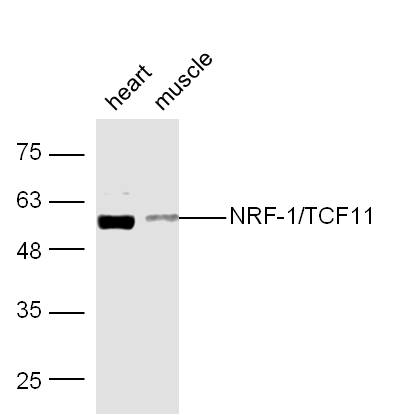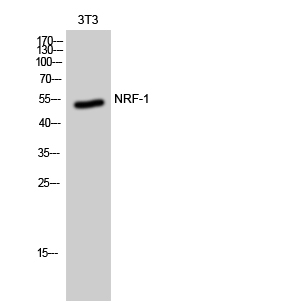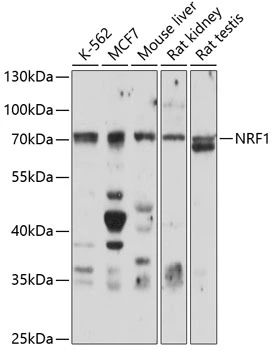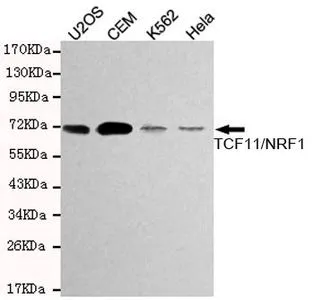NRF1 antibody
GTX103179
ApplicationsImmunoFluorescence, ImmunoPrecipitation, Western Blot, ImmunoCytoChemistry, ImmunoHistoChemistry, ImmunoHistoChemistry Paraffin
Product group Antibodies
ReactivityHuman, Mouse, Rat
TargetNRF1
Overview
- SupplierGeneTex
- Product NameNRF1 antibody
- Delivery Days Customer9
- Application Supplier NoteWB: 1:500-1:3000. ICC/IF: 1:100-1:1000. IHC-P: 1:100-1:1000. IP: 1:100-1:500. *Optimal dilutions/concentrations should be determined by the researcher.Not tested in other applications.
- ApplicationsImmunoFluorescence, ImmunoPrecipitation, Western Blot, ImmunoCytoChemistry, ImmunoHistoChemistry, ImmunoHistoChemistry Paraffin
- CertificationResearch Use Only
- ClonalityPolyclonal
- Concentration1.69 mg/ml
- ConjugateUnconjugated
- Gene ID4899
- Target nameNRF1
- Target descriptionnuclear respiratory factor 1
- Target synonymsALPHA-PAL, nuclear respiratory factor 1, alpha palindromic-binding protein
- HostRabbit
- IsotypeIgG
- Protein IDQ16656
- Protein NameNuclear respiratory factor 1
- Scientific DescriptionThis gene encodes a protein that homodimerizes and functions as a transcription factor which activates the expression of some key metabolic genes regulating cellular growth and nuclear genes required for respiration, heme biosynthesis, and mitochondrial DNA transcription and replication. The protein has also been associated with the regulation of neurite outgrowth. Alternate transcriptional splice variants, which encode the same protein, have been characterized. Additional variants encoding different protein isoforms have been described but they have not been fully characterized. Confusion has occurred in bibliographic databases due to the shared symbol of NRF1 for this gene and for nuclear factor (erythroid-derived 2)-like 1 which has an official symbol of NFE2L1. [provided by RefSeq]
- ReactivityHuman, Mouse, Rat
- Storage Instruction-20°C or -80°C,2°C to 8°C
- UNSPSC12352203
References
- Liang MZ, Lu TH, Chen L. Timely expression of PGAM5 and its cleavage control mitochondrial homeostasis during neurite re-growth after traumatic brain injury. Cell Biosci. 2023,13(1):96. doi: 10.1186/s13578-023-01052-0Read this paper
- Mesquita PHC, Godwin JS, Ruple BA, et al. Resistance Training Diminishes Mitochondrial Adaptations to Subsequent Endurance Training. bioRxiv. 2023,:pii: 2023.04.06.535919. doi: 10.1101/2023.04.06.535919.Read this paper
- Mesquita PHC, Osburn SC, Godwin JS, et al. Effects of aging and long-term physical activity on mitochondrial physiology and redox state of the cortex and cerebellum of female rats. Physiol Rep. 2022,10(24):e15542. doi: 10.14814/phy2.15542Read this paper
- Chen JW, Ma PW, Yuan H, et al. mito-TEMPO Attenuates Oxidative Stress and Mitochondrial Dysfunction in Noise-Induced Hearing Loss via Maintaining TFAM-mtDNA Interaction and Mitochondrial Biogenesis. Front Cell Neurosci. 2022,16:803718. doi: 10.3389/fncel.2022.803718Read this paper
- Mesquita PHC, Lamb DA, Parry HA, et al. Acute and chronic effects of resistance training on skeletal muscle markers of mitochondrial remodeling in older adults. Physiol Rep. 2020,8(15):e14526. doi: 10.14814/phy2.14526Read this paper
- Ma B, Cheng H, Mu C, et al. The SIAH2-NRF1 axis spatially regulates tumor microenvironment remodeling for tumor progression. Nat Commun. 2019,10(1):1034. doi: 10.1038/s41467-019-08618-yRead this paper
- Lee CT, Wang JY, Chou KY, et al. 1,25-Dihydroxyvitamin D(3) modulates the effects of sublethal BPA on mitochondrial function via activating PI3K-Akt pathway and 17β-estradiol secretion in rat granulosa cells. J Steroid Biochem Mol Biol. 2019,185:200-211. doi: 10.1016/j.jsbmb.2018.09.002Read this paper
- Zhang Y, Humes F, Almond G, et al. A mitohormetic response to pro-oxidant exposure in the house mouse. Am J Physiol Regul Integr Comp Physiol. 2018,314(1):R122-R134. doi: 10.1152/ajpregu.00176.2017Read this paper
- Chen YH, Lin WW, Liu CS, et al. Caveolin-1 Expression Ameliorates Nephrotic Damage in a Rabbit Model of Cholesterol-Induced Hypercholesterolemia. PLoS One. 2016,11(4):e0154210. doi: 10.1371/journal.pone.0154210Read this paper
- Chiang MC, Cheng YC, Nicol CJ, et al. Rosiglitazone activation of PPARγ-dependent signaling is neuroprotective in mutant huntingtin expressing cells. Exp Cell Res. 2015,338(2):183-93. doi: 10.1016/j.yexcr.2015.09.005Read this paper







